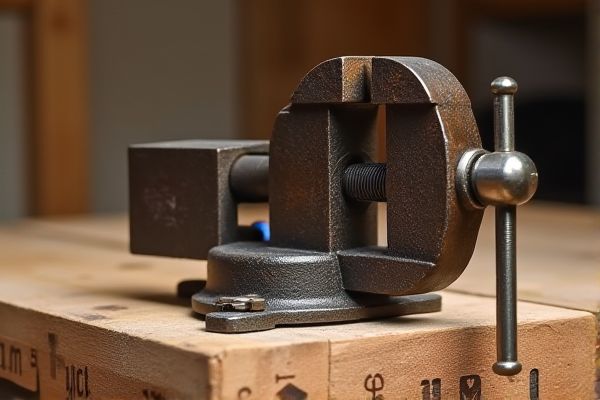
A bench vise provides a strong, fixed grip that is ideal for heavy-duty tasks requiring stability, while clamps offer more versatility and portability for quick, adjustable holds in various positions. Discover which tool suits Your projects best by reading the full comparison in the rest of the article.
Table of Comparison
| Feature | Bench Vise | Clamp |
|---|---|---|
| Primary Use | Securing workpieces for detailed work | Holding materials temporarily during work |
| Mounting | Fixed to workbench | Portable, attaches via screw or lever |
| Holding Strength | High, stable grip | Moderate, adjustable pressure |
| Portability | Low, heavy and fixed | High, lightweight and movable |
| Typical Materials | Metal, wood, plastic | Wood, metal, plastic, composites |
| Common Applications | Metalworking, woodworking, welding | Woodworking, gluing, light assembly |
| Price Range | Medium to high | Low to medium |
Introduction to Bench Vise and Clamp
Bench vises provide a sturdy, fixed grip for heavy-duty woodworking and metalworking tasks by mounting securely to a workbench, offering precise stability and leverage. Clamps, available in various types such as C-clamps and bar clamps, deliver versatile, adjustable pressure to hold materials temporarily in place during gluing or assembly. Both tools are essential for maintaining workpiece position, but bench vises excel in permanent, stable holding while clamps offer flexibility and portability.
Key Differences Between Bench Vises and Clamps
Bench vises provide a fixed and stable grip with jaws that are tightened by a screw mechanism, making them ideal for heavy-duty tasks requiring strong, immovable holding power. Clamps offer versatility with adjustable pressure and quick-release options, suited for scenarios where temporary or repositionable fastening is needed. Understanding these key differences helps you select the most efficient tool for your specific woodworking or metalworking projects.
Design and Construction Comparison
Bench vises feature a robust, fixed jaw design with a screw mechanism for precise clamping and heavy-duty tasks, often constructed from cast iron or steel for maximum durability. Clamps offer more versatility with adjustable sizes and portable designs, typically made from lighter materials like aluminum or plastic composites. Your choice depends on whether you need the stability of a bench vise or the flexibility of a clamp for various projects.
Functionality and Applications
A bench vise provides a secure, stationary grip ideal for heavy-duty tasks such as metalworking, woodworking, and assembly, offering superior stability for precision and forceful operations. Clamps are versatile and portable, suitable for temporarily holding materials in place during gluing, drilling, or light fabrication, allowing flexibility across various projects. Your choice between bench vises and clamps depends on the need for either consistent, strong holding power or adjustable, quick fastening in diverse applications.
Strength and Holding Capacity
Bench vises offer superior strength and holding capacity due to their robust construction, typically made of cast iron or steel, providing firm and stable grip for heavy-duty tasks. Clamps, though versatile and portable, generally provide less holding force and are better suited for lighter or temporary holds. Your choice depends on whether you need maximum stability for rigorous work or flexible, adjustable grip for varied projects.
Versatility in Workshops
Bench vises offer robust stability and precision for heavy-duty tasks such as metalworking, woodworking, and assembly, making them ideal for repetitive, high-pressure applications. Clamps provide greater flexibility and adaptability, easily securing irregular or delicate objects and allowing quick repositioning across various surfaces. Workshops benefit from incorporating both tools to enhance overall versatility, accommodating a wide range of project requirements with efficiency and reliability.
Ease of Use and Adjustability
Bench vises offer superior stability and quick one-handed operation, making them easy to use for securing heavy or awkward workpieces. Clamps provide greater adjustability with versatile positioning options, ideal for tasks requiring frequent repositioning or lighter holding force. Your choice depends on whether you prioritize ease of consistent firmness or flexible, adaptable holding during your project.
Space and Portability Considerations
Bench vises are typically bulky and fixed to workbenches, limiting portability and requiring ample workspace for installation. Clamps offer significant space-saving advantages due to their lightweight, adjustable design, allowing you to secure materials in various locations without permanent attachment. If your projects demand mobility or you have limited workshop space, clamps provide a more practical and versatile solution.
Price and Value for Money
Bench vises typically cost more upfront than clamps but offer greater durability and stability for heavy-duty tasks, providing better long-term value for professionals and frequent users. Clamps are generally less expensive and more versatile for quick, temporary holds, making them a budget-friendly choice for occasional or light-duty projects. Evaluating price against intended use reveals that vises deliver superior performance and value in demanding work, while clamps offer cost-effective convenience for less intensive applications.
Which Tool Should You Choose?
A bench vise provides a stable, immovable grip ideal for heavy-duty tasks requiring maximum holding power, making it perfect for metalworking or woodworking projects needing precise control. Clamps offer versatility and portability, suitable for temporary holds on various surfaces and materials, ideal for quick adjustments or when working on irregular shapes. Choose a bench vise for long-term, stable workstations and clamps for flexible, on-the-go securing needs.
 homyna.com
homyna.com